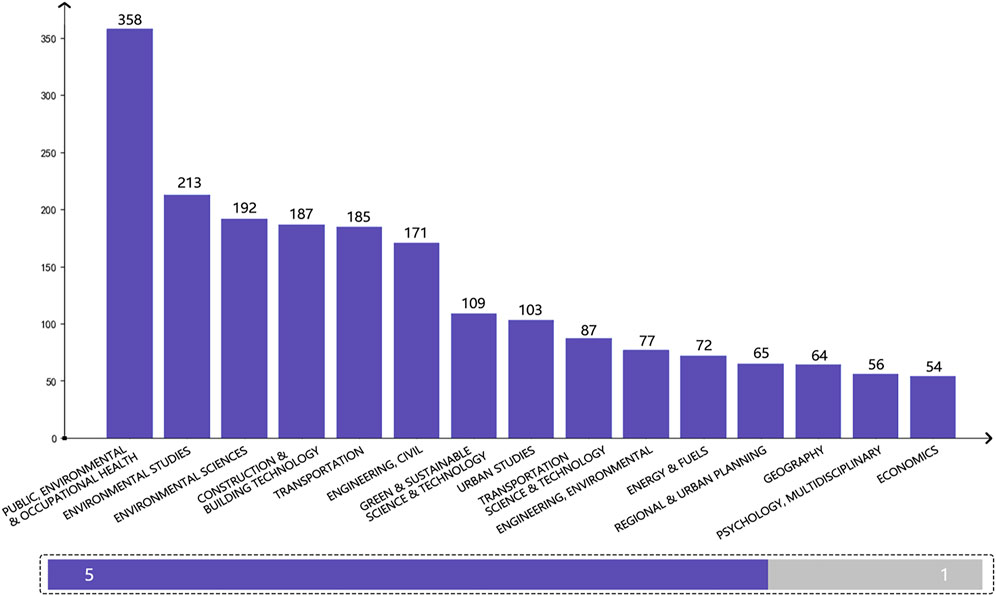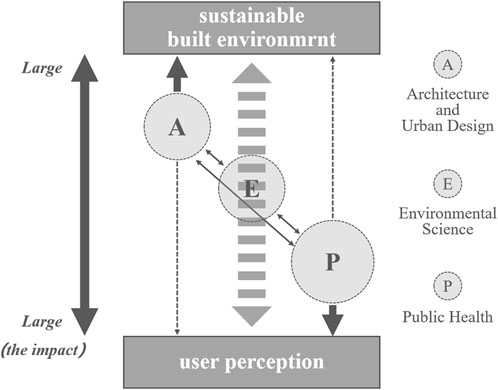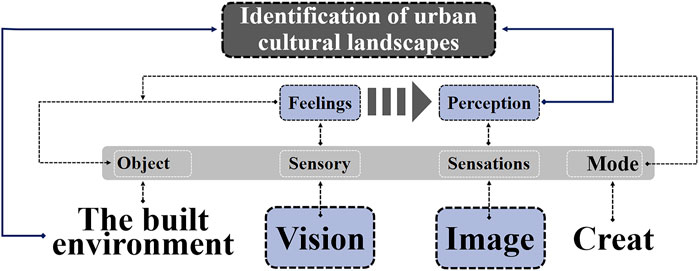- School of Architecture, Key Laboratory of Cold Region Urban and Rural Human Settlement Environment Science and Technology, Harbin Institute of Technology, Ministry of Industry and Information Technology, Harbin, China
The study of the relationship between sustainable built environment and user perception has often taken a single perspective, displaying neither a holistic view of the relationship nor a systematic and refined grasp of the research content previously. This has resulted in a biased understanding of the two research objects and their respective measurement methods and made it difficult to develop synergies. In this context, this paper summarises the current research hotspots and trends in the relationship between sustainable built environment and user perception through CiteSpace quantitative analyses such as keyword co-occurrence networks, emergent word detection, and disciplinary re-clustering, and takes a multidisciplinary perspective to focus on relevant research in public health, environmental science, and architecture and urban design, such as the progress of research between sustainable built environment and users in physical activity, environmental cognition, and image perception. The results show that in the environmental science field, environmental cognition is the core, based on the study of users’ direct perception of sustainable built environment and its externalisation in the expression of behaviours. The public health field and the architecture and urban design field are dominated by the study of perceptual outcomes. There is a trend towards big data as a measurement tool for research subjects in all fields with a multidisciplinary perspective and the inclusion of more disciplines can produce more meaningful research results. The study provides a framework for research into the relationship between the two from a broader perspective and provides guidance for future multidisciplinary research, with implications for the construction of high-quality human-centred urban spatial environments.
1 Introduction
The built environment is often defined as the human environment, such as communities, workplaces, and road environments (JF, 2006). Studies have shown that the built environment has a strong correlation with the health of the population (Gold, 1980; Barton, 2009), but the mechanisms by which it affects health are complex. This is due to the combined effects of specific social and economic conditions and individual usage patterns, along with environmental influences, including physical activity (Hur et al., 2010) and environmental pollution (Diez Roux and Mair, 2010). The rapid development of modern industrial cities has led to a series of public health problems caused by the reduced quality of the built environment. Such rapid development has gradually worsened the problems of resource scarcity, traffic congestion, and air pollution, and given rise to many disorders, such as homogeneity, chaos, and inhuman scale, (Chen et al., 2020), which, in turn, have led to the compression of social space as well as health problems, such as obesity and chronic diseases (Lu and Tan, 2015). Based on numerous empirical studies in Western countries, urban built environment factors such as housing conditions, building density, green space (Evans et al., 2003; Nielsen and Hansen, 2007; Van den Berg et al., 2010), neighbourhood support, and the degree of chaos in the neighbourhood (Kim, 2010; Qin et al., 2018) have a significant impact on residents’ mental health. The design of the built environment has a strong guiding effect on people’s daily lives and behaviour patterns (Liu and Guo, 2006). It is, therefore, necessary to examine whether the built environment meets the behavioural and psychological needs of residents, and how more refined, humanistic planning and design could improve the quality of urban space to enhance their sense of wellbeing and access. This has become one of the main directions for the improvement of built environment (Cao and Ettema, 2014). This is also a main issue that needs to be addressed in the process of urban physical examination and development of new cities.
Environmental perception refers to a person’s awareness or feeling of the environment and the act of understanding the environment through the senses (Wang L. et al., 2020). Environmental perception of the built environment by people is the most direct result of the relationship between the two, such as the visual quality of streets and satisfaction with urban parks and green spaces (Altman and Zube, 2012). Individual perception of the built environment is influenced by a variety of factors, such as individual economic attributes, social environment, and spatial and psychological characteristics (Chen et al., 2017). Measuring residents’ perceptions of the built environment can help analyse the relationship between their health and the various components of the built environment (Dong et al., 2020). Early studies on the impact of the built environment on resident health focused on the impact on physical activity and its health effects: the former was mostly in the fields of environmental science and public health (Kearns and Moon, 2002); the latter was in the fields of recreation and healthcare; and there was a lack of systematic and diverse studies on the built environment impact factors and pathways on resident health (Andrews and Evans, 2008). Existing studies on the perception of the built environment are very rich in connotations, covering various aspects, such as sensory perceptions of sight, hearing, smell, and touch (Xi et al., 2019); perceptions of community facilities and spatial forms (Zhu and Zhai, 2019); evaluation dimensions, such as the sense of safety and comfort in the environment (Chen et al., 2017); as well as high-level environmental experiences such as satisfaction (Carr et al., 2010), happiness (Dong and Qin, 2017), community identity, and emotional attachment (Wang, 2018), etc. Nowadays, the impact of the sustainable built environment on resident health is increasingly receiving focused attention from the fields of urban and rural planning, sociology, medicine, and other disciplines.
Some scholars have attempted to define ‘multidisciplinarity’ and ‘interdisciplinarity’. They argue that multidisciplinarity draws on knowledge from different disciplines but stays within their respective boundaries. Generally speaking, collating the views of researchers from different disciplines on the same issue from their respective disciplines is called ‘multidisciplinary research’ and is often found in project applications. Interdisciplinary research is more concerned with methodological and theoretical aspects (Alvargonzález, 2011). Multidisciplinary and interdisciplinary research are often combined (Wu, 2021). The National Academy of Sciences defines ‘interdisciplinarity’ as a mode of research in a discipline in which a research team or individual integrates information, data, working perspectives, concepts, or theories from two or more disciplines or fields of expertise to solve or understand a problem that could not be solved by a single discipline or area of research practice alone and to break free from the constraints of a single disciplinary perspective (Committee on Facilitating Interdisciplinary Research and National Academy of Sciences, National Academy of Engineering, 1900). ‘Sustainability’ is multiple things at once and navigates interesting territory—it is a goal, an ideal, an umbrella, and a sub-discipline of multiple disciplines (Reyers et al., 2010). Clarifying the relationship between sustainable built environment and user perception is an important part of alleviating urban problems, improving the quality of the living environment, and enhancing urban refinement. This paper takes a multidisciplinary approach to the analysis of the design of human-centred spaces in the context of public health, environmental science, architectural engineering, transport, and urban planning. The multidisciplinary nature of conservation science has long been recognised, but seldom achieved. Multidisciplinarity features several academic disciplines in a theme-based investigation with multiple goals—essentially, studies “co-exist in a context” (Petts et al., 2008). If subdivided, multidisciplinary research focuses on collecting and comparing research results without attempting to cross boundaries (Tress et al., 2005). It is seen as a step up from multidisciplinary research, focusing on synthesising knowledge and generating new and different perspectives, rather than simply reproducing them (Attwater et al., 2005; Petts et al., 2008). It is a process of answering, solving, or posing a question that is more involved and complex than a single discipline can handle, drawing on various perspectives and integrating the results of various disciplines with the aim of developing a more integrated understanding and expanded perception.
Thus, the paper analyses the relationship between sustainable built environment and user perception from a multidisciplinary perspective, using a high-level view to make a clear link within the huge network of relationships, adopts an interdisciplinary approach to describe the research and its different aspects in more detail, synthesises and analyses the results of the research in order to generate new knowledge helpful for further research, outlines the current state of research using CiteSpace, understands the distribution characteristics of multidisciplinary fields, and summarises them into three major research areas. It is hoped that this will provide a reference for subsequent academic research and built environment-related design.
2 Research methodology
2.1 Study design
This paper begins with the design of a research framework (Figure 1). Through a preliminary reading of theory and literature, the research questions and directions were identified: the study of the relationship between sustainable built environment and user perception. The research scope was then clarified and the research concepts defined. This paper uses the literature information visualisation software CiteSpace (Chen et al., 2015) as the main analysis tool to 1) understand the total number of publications on the relationship between sustainable built environment and user perception and the regional distribution characteristics of the research objects in the literature; 2) explore the disciplinary distribution characteristics based on Web of Science (WoS) categories and related research literature; 3) use the keyword co-occurrence network and frequency analysis to study the relationship between sustainable built environment and user perception; 4) use the co-authorship network and frequency of keyword citation articles to analyse the core figures and research results of the relationship between sustainable built environment and user perception and combine with the clustering table to summarise the three main research areas; 5) based on the results of the inductive analysis, explore the future research directions of the relationship between sustainable built environment and user perception from three aspects: public health, environmental science, and architecture and urban design, in order to provide reference and guidance for subsequent multidisciplinary cross-research and cooperation, as well as subsequent optimisation of sustainable built environment.
2.2 Data acquisition
With the advent of the era of big data, the visualisation of relationships between categories of knowledge is increasingly valued by scholars. In order to ensure the comprehensiveness and accuracy of data, this paper uses the WoS core database as the data collection platform and CiteSpace software to draw and analyse the corresponding map. User perception also includes psychological needs and perceptions of sustainable built environment, so in addition to the general term ‘user perception’, specific psychological perception phrases are added, including ‘safety’, ‘comfort’, ‘enjoyment’, ‘wellbeing’, ‘perceptibility’, and ‘playfulness’. Weakly related keywords such as ‘satisfaction’ and ‘walkability’ are excluded to ensure the comprehensiveness of the search results, and therefore, the search has shortcomings. After running several searches and filters to ensure that the search terms were as core as possible, ‘sense of pleasure’ and ‘palpable’ were removed; ‘safety’ was used instead of ‘security’; and the advanced search formula TS=(sustainable built environment and (perception of user or perception of safety or comfortable sensation or happiness or playability)) was used. 2,465 documents were obtained. 1,870 journal articles were selected as the data source for this study by manually removing the papers that were double counted, with a data download date of 03 December 2022.
3 Review of literature on the relationship between sustainable built environment and user perception
The research on the relationship between sustainable built environment and user perception has a long history and was first started in Europe and the United States, which includes a great variety of contents, disciplines and research methods, but there are connections and overlaps in the internal structure. The analysis of the number of publications per year and regional distribution characteristics can show the hotspot time and region for the research on the relationship between sustainable built environment and user perception. The analysis of the Author collaboration network can show the key researchers and important papers for the research on the relationship between the two, in order to clearly define the research line and development direction. The analysis of the characteristics of the subject areas can clearly show the variety and complexity of the research content, which can clarify the main subject areas and essentially capture the core relationship between user perception of the sustainable built environment, and analyse the future development direction with the research hotspots’ map.
3.1 Number of publications per year and regional distribution characteristics
The change in the number of publications reflects the level of attention and research on the topic. This paper presents a statistical analysis of the year-on-year changes in the number of publications on sustainable built environment and user perception (Figure 2). It shows that the annual number of publications on this topic has generally shown an upward trend since 2003 and exceeded 200 in 2020, indicating that scholars at home and abroad have gradually paid more attention to research on the relationship between the two in recent years. The research history can be divided into three phases: the first phase before 2003, when there was basically no research in this field, indicating that the relationship between sustainable built environment and user perception had not yet attracted the attention of scholars at the time; the second phase of slow development, 2004–2011, when people gradually paid more attention to their built environment as their material living standards improved; the third stage of rapid growth, 2012–2022, with a significant increase in the number of annual publications and active research dynamics, proving that user perception of built environment has become a popular aspect of the relationship between built environment and users, and also reflecting the importance and pursuit of people’s spiritual feelings. Theoretical guidance was needed to keep pace with the growing material culture.
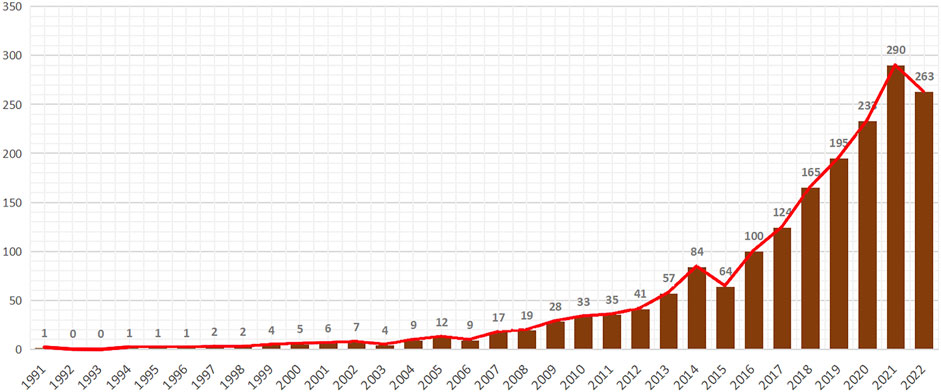
FIGURE 2. Trend of the number of studies on the relationship between sustainable built environment and user perception.
The regional distribution of the literature can visually reflect the popular countries and regions for research on the relationship between sustainable built environment and user perception. As can be seen in Figure 3, most of the scholars studying the relationship between the two are concentrated in the US, China, the United Kingdom, Australia, and Canada. The regional distribution of the literature also shows that the US is the earliest researcher on the topic and has a greater influence on other countries. As one of the most popular countries for research in this area, most of the research on the relationship between the two in China occurred after 2015, which is highly consistent with the third stage. This is closely related to China’s urbanisation process, which reached a new level of domestic construction after two stages of expansion and coordinated development between 1993 and 2012.

FIGURE 3. Knowledge map of the regional distribution of literature on the relationship between sustainable built environment and user perception.
3.2 Author collaboration network
The network mapping of co-authorship shows the relationships between scholars in the field, with larger nodes indicating greater influence of the scholar. Using CiteSpace to analyse the downloaded literature for co-authorship (Figure 4) yielded 654 nodes and 737 links, with a density of 0.0035. The analysis, combined with the regional distribution of the literature (Figure 3), shows that relevant research in the United Kingdom and the US began long ago, with clear collaborative relationships between authors, with Ilse De Bourdeaudhuij, James F. Sallis, and Benedicte Deforche being the most influential in the field and laying the foundation for research, while research in China started a little later but since gained great momentum, with Zhang Yin, Wang Zhe, and Liu Hong being more influential. Jacqueline Kerr, James F. Sallis, and others (Kerr et al., 2016), examining the strength and shape of the relationship between adults’ perceptions of community and walking and cycling for transport in different environments, point out that many perceived environmental attributes support walking and cycling, that in a highly walkable environment, people are less likely to cycle as they choose to walk, and that these findings could guide the implementation of global health strategies. Ilse De Bourdeaudhuij and Benedicte Deforche together with Jelle Van Cauwenberg and other researchers (Van Cauwenberg et al., 2012) qualitatively studied the influence of the physical environment on older people’s choice to walk, identifying influential elements such as functional facilities, walking facilities, traffic safety, familiarity, crime safety, social contact, aesthetics, and weather, and specifically stated that in order to encourage walking, the community should have more services and social spaces, and the perception of the environment should focus on crime prevention and a sense of security. Ester Cerin and Billie Giles-Corti work closely with the above researchers James F. Sallis and Ilse De Bourdeaudhuij. The IPEN (International Physical Activity and Environment Network) Recognition Project sought to aggregate and analyse the perceived community environment through the Neighbourhood Environment Walkability Scale (NEWS) and its intermittent version (NEWS-a) measure, using physical activity data from 12 countries and proposing country-specific modifications to the original NEWS/NEWS-a scoring scheme to improve comparability between countries, although some differences between countries remain and need to be taken into account when interpreting the results for each country (Cerin et al., 2013).
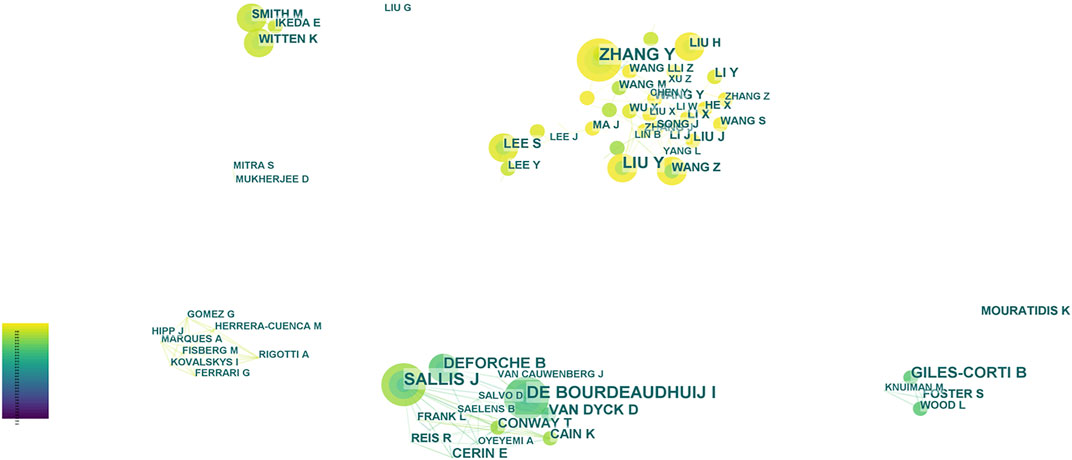
FIGURE 4. Authors’ collaborative knowledge map for research of the relationship between sustainable built environment and user perception.
3.3 Subject area characteristics
In this paper, a preliminary statistical analysis of the resulting 1815 documents according to WoS categories reveals that the research presents a characteristic of concentration in certain types of subject areas (Figure 5). The top fifteen categories are extracted for comparison with the others, with a ratio of about 5:1. The histogram of the top 15 categories shows that ‘public, environmental & occupational health’ is the largest with 358 articles, indicating that the relationship between built environment and users is of great interest to the public health sector. The categories ‘environmental studies’ and ‘environmental sciences’ account for more than 20% of the total number of articles, mainly due to their inherent properties related to sustainable built environment and user perception of the environment. The category ‘architectural engineering’, as an externalised manifestation of the relationship between the two, also receives a higher number of articles.
The co-occurrence mapping of subject areas derived from CiteSpace shows that ‘public, environmental & occupational health’, ‘environmental studies’, ‘construction & building technology’, ‘civil engineering’, ‘transport’, and ‘environmental sciences’ have a high citation intensity, while other clear nodes are ‘green & sustainable science & technology’, ‘urban science & technology’, ‘urban studies’, and other environmental disciplines (Figure 6).
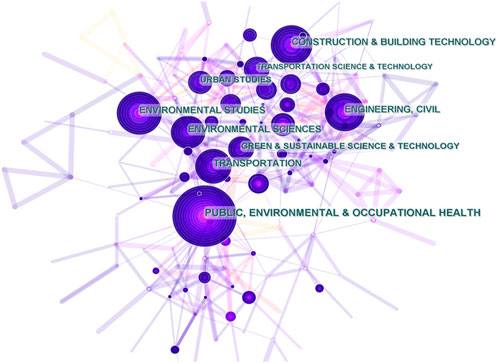
FIGURE 6. A disciplinary co-occurrence network for the study of the relationship between sustainable built environment and user perception.
The size of the nodes in the graph indicates the level of citation intensity, the line between the nodes represents the year when the literature between the two disciplines was first cited together, and the change in the brightness of the colour indicates how early research on the relationship between sustainable built environment and user perception emerged in the field, with the bluer the colour, the later the emergence. It can be seen that early research focused on the discipline of ‘public, environmental & occupational health’, but after 2009, the field of research on this topic began to expand with ‘environmental studies’, ‘construction & building technology’, ‘engineering, civil’, and ‘geography’. After 2015, the original field of study expanded further, with ‘urban studies’, ‘regional & urban planning’, and other disciplines focusing on the relationship between sustainable built environment and user perception. The categories ‘urban studies’, ‘regional & urban planning’, etc. have all addressed this issue.
In general, with the gradual expansion and deepening of research on the relationship between sustainable built environment and user perception, research on the topic has now formed an obvious ‘one centre + two nodes + a number of branches’ research structure layout, with the field of environmental science as the centre, and the field of public health and the field of architecture and urban design as the two nodes. In terms of research content, the field of environmental science serves as the core field of relationship between the two. In relationship research, the field of architecture and urban design is more inclined to the analysis and design of sustainable built environment, while the field of public health pays more attention to the perception and behavioural characteristics of users. The field of research has recently crossed over into the disciplines of psychology and computer science, reflecting the multidisciplinary and cross-study nature of this thematic research (Figure 7).
3.4 Research hotspots and trend analysis
In this paper, we used the CiteSpace software to analyse the keyword co-occurrence network and frequency of 1815 documents on the relationship between sustainable built environment and user perception from 1991 to 2022, with a 1-year time slice, node type ‘keyword’, pruning settings ‘pathfinder’ and ‘pruning sliced networks’, and other parameters as default. A network density of 0.0114 was obtained for 688 document nodes with 2,699 lines (Figure 8). The data was further counted and the top 20 high-frequency keywords were obtained (Table 1). As this study searched for ‘built environment’ and user perception’ as topics, the two keywords ‘built environment’ and ‘perception’ were excluded. The remaining high-frequency keywords in this area were ‘physical activity’, ‘health’, ‘walking’, ‘environment’, ‘impact’, ‘behaviour’, ‘perception of behaviour’, ‘design’, etc. As can be seen, the high-frequency keywords corresponded well to the characteristics of the disciplinary distribution mentioned above. The keywords ‘physical activity’, ‘health’, and ‘walking’ were more often studied in the context of public health, especially the topic ‘physical activity’. The keywords ‘environment’, ‘thermal comfort’, ‘happiness’, ‘satisfaction’, and ‘safety’ were more often associated with the field of environmental science. For example, Honf and Chen (Hong and Chen, 2014) studied the relationship between built environment, crime perception, and people’s walking behaviour. The study showed that people’s perceptions of the built environment affect their travel and use. The keywords ‘urban design’, ‘quality’, ‘virtual reality’, and ‘urban form’ are mostly based on architecture and urban design, using people’s perceptions of the built environment to identify and perceive urban images or landscapes.
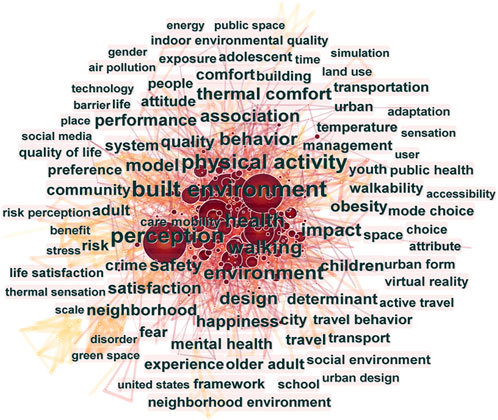
FIGURE 8. Keywords co-occurrence network diagram for the study of the relationship between sustainable built environment and user perception.

TABLE 1. Keywords ranking list for the study of the relationship between sustainable built environment and user perception.
Based on this, this paper used CiteSpace to cluster the literature nodes based on keywords, drew words from them by ‘log-likelihood rate’ to identify clusters, and obtained a total of 12 sub-clusters (Figure 9) with ‘modularity Q = 0.5232 > 0.3’ and ‘silhouette S = 0.7621 > 0.7’, which had a significant group structure and sufficient confidence (Chen et al., 2010). Sub-clusters ranged from ‘thermal comfort’ and ‘physical activity’ to ‘quality’ and ‘neighbourhood environment’, whereas ‘cancer causation’ was weakly related to the study topic and therefore excluded.
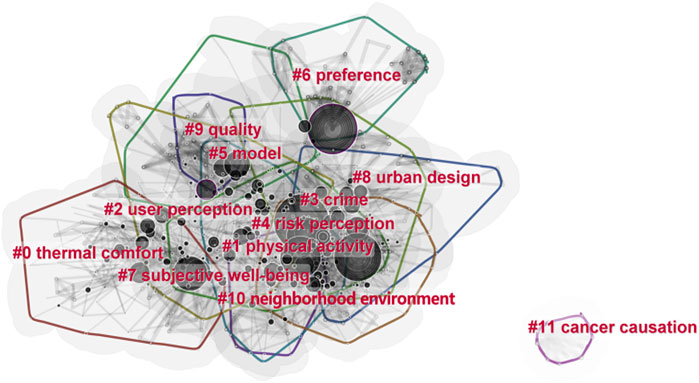
FIGURE 9. Keywords co-occurrence clustering map for the study of the relationship between sustainable built environment and user perception.
Combining Figure 10, it can be seen that the initial health-related terms ‘walking’, ‘physical activity’, and ‘environmental perception’ have matured and the research hotspots are gradually moving towards ‘urban scale’ and ‘emerging technologies’, with terms such as ‘neighbourhood design’, ‘city’, ‘virtual reality’, and ‘machine learning’ showing recent mutations.
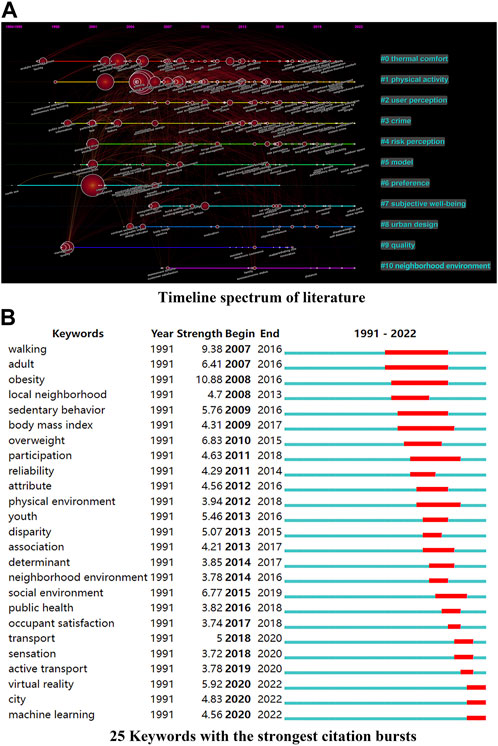
FIGURE 10. the Hotpots’ tendency for the study of the relationship between sustainable built environment and user perception. (A) Timeline spectrum of literature (B) 25 Keywords with the strongest citation bursts.
4 Trends in research on the relationship between built environment and user perception from a multidisciplinary perspective
The top ten references were filtered according to the frequency of citations. When analysing the journal sources of the cited literature, journals dealing with health and perception and the design of built environment at different scales dominated (Table 2), and almost half of them focused directly on the relationship between environment and perception. The authors of the highly cited literature were mostly from three disciplinary backgrounds, namely, health, environment, and architecture and urban planning, reflecting to some extent the disciplines’ health benefits and value as sources for promoting research on improving built environment.
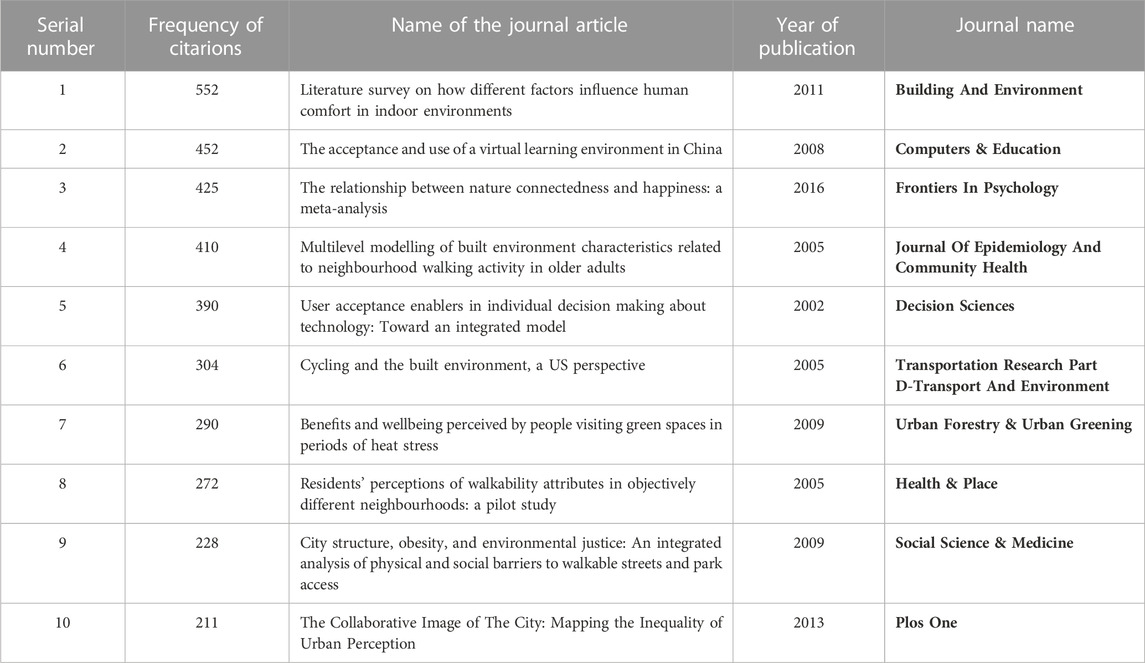
TABLE 2. Top 10 cited literature for the study of the relationship between sustainable built environment and user perception.
Based on Table 2, the results are integrated according to the CiteSpace cluster analysis map to obtain Table 3, which shows that the research on the relationship between sustainable built environment and user perception, based on a multidisciplinary perspective, is divided into three main areas of concern: public health, environmental science, and architecture and urban design, with the corresponding research focus on ‘health behaviour’, ‘environmental cognition’, and ‘image perception’. The three fields differ in their respective points of focus on the relationship: environmental science focuses directly on the mechanisms underlying the relationship, with an emphasis on quantifying and analysing user perception of sustainable built environment, whereas public health as well as architecture and urban design focus on applied research, with an emphasis on analysing, filtering, and applying perceptions within their own fields of study. The respective research trends are elaborated in all three areas.
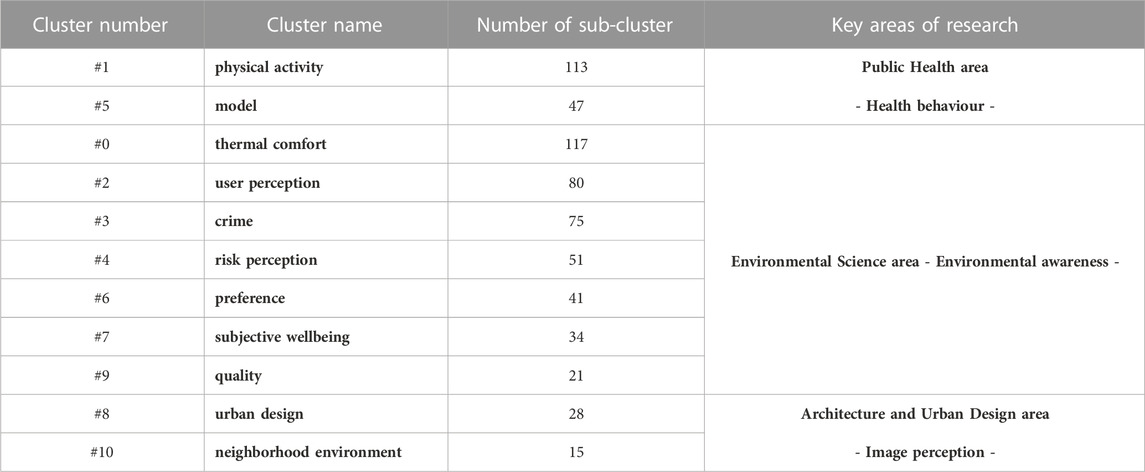
TABLE 3. Keywords clustering analysis for the study of the relationship between sustainable built environment and user perception.
4.1 External representation of the relationship between sustainable built environment and user perception from a public health perspective
From a public health perspective, sustainable built environment has a profound impact on the health of their users through the externalisation of user perception of the environment and their self-selection. Studies have shown that built environment has a strong correlation with user health (Barton, 2009). Environmental categories that could influence people’s behaviour patterns, such as food resources, information patterns, public facilities, and medical environments, have all been addressed in the study of built environment from a public health perspective (Ma and Cai, 2016). Thus, the relationship between sustainable built environment and user perception has become more of a health-oriented behavioural profile, and more disciplines are now focusing on the role of the environment in influencing population health, such as urban and rural planning, health geography, sociology, medicine, etc. Sallis et al. (Sallis et al., 2006) put forward the famous social ecology theory based on the intersection of multidisciplinary fields at the time, summarised a more complete active living ecological model based on a large number of health behaviour theories, and sorted out the elements of environmental interventions to promote health behaviour, which expanded the scope of research to explore the relationship between sustainable built environment and user perception based on health behaviour research. In A New Perspective on the Health of Canadians, Lalonde (1974) identified lifestyle, environment, medical facilities, and human biology as the four most important factors influencing health, with non-communicable diseases overtaking communicable diseases as the main threat to human life (except in specific emergencies). The ‘environment’ is the external factor affecting human health, while ‘human biology’ is broadly defined as the body’s own characteristics, especially certain hereditary diseases such as obesity, hypertension, and myopia. The four types of elements interact with each other, with health-related behaviours being an important area of public health research into the relationship between the sustainable built environment and user perception, as well as an important way of influencing human health, of which physical activity is a particularly important part. The relationship between behaviour and health under the three main acquired factors of environmental quality, medical facilities, and obesity, as well as the relationship between human biology and physical activity are analysed below (Figure 11).
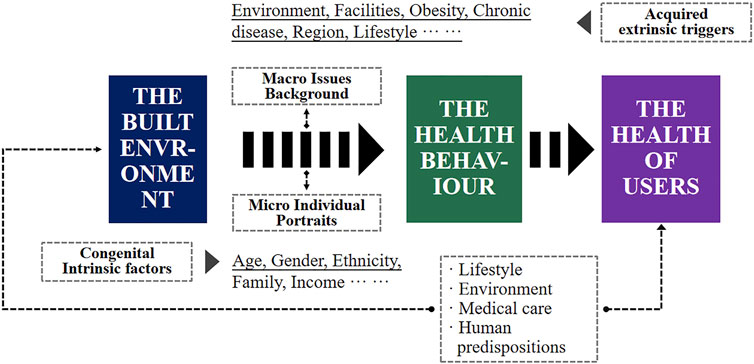
FIGURE 11. Graphical representation of the relationship between sustainable built environment and health behaviour.
4.1.1 Research of behavioural patterns based on a multi-genre context of the times
In different contexts, user perception of various aspects of sustainable built environment influences corresponding behavioural patterns. In a multi-dimensional context, with the development of built environment and social awareness, the behavioural patterns of residents are becoming more complex, with significant health implications. The planning and design of sustainable built environment should, therefore, use the interdisciplinary research results and take into account environmental, social, and economic factors in order to promote the adoption of healthier and more sustainable behavioural patterns. Long-term indoor stay could lead to problems such as sedentariness and lack of exercise; crowding of activity and interaction spaces could lead to physical health problems such as obesity, respiratory diseases, and chronic illnesses (Lu and Tan, 2015); highly homogeneous urban environments and increasing social pressures could lead to mental health problems such as anxiety, loneliness, and depression (Qin et al., 2018). These suggest that sustainable built environment should not only focus on the physical aspects of sustainability, but also consider how to create more socially interactive and emotionally resonant spaces to improve user mental health.
In the context of the growing problem of environmental pollution in urban areas, air pollution (e.g., PM2.5) has become one of the major factors threatening the health of residents (Gee and Payne-Sturges, 2004). Due to the low quality of the environment, people are reluctant to spend too much time outdoors. Also, activities such as walking and cycling can only take place in certain places, making travel behaviour increasingly homogeneous. Studies of residents’ travel behaviour have analysed the impact of factors such as mode of transport and commute time on their health status (Macmillan et al., 2013). For example, Yang and French (Yang and French, 2013) studied the relationship between transport use and body mass index (BMI). The analysis of air pollution exposure based on individual behavioural research paradigms in residential travel patterns and micro-behavioural settings would be one of the frontier topics.
In the context of equalisation of services, research on access behaviour could provide a basis for optimal allocation of healthcare resources, with accessibility and individual factors being the most critical. Andersen’s model of healthcare behaviour is a widely used classic model that categorises the factors that influence an individual’s decision to seek medical care as ‘predisposing factors’, ‘enabling factors’, and ‘need factors’ (Kehrer et al., 1972). In sustainable built environment, this model also needs to be integrated with environmental accessibility and user perception to ensure that healthcare resources are allocated appropriately and people’s needs are met.
In the context of the rapidly growing obesity problem, the density of housing in built environment (Rodríguez et al., 2009), the number of commercial establishments (Nagel et al., 2008), the land mix, the walkability of neighbourhoods (Li et al., 2009), the density of public transport (Bird et al., 2009) etc. influence people’s physical activity and thus their levels of obesity, but even more relevant is the food service environment, which could also lead to obesity if it does not offer healthier foods and there is an imbalance between energy intake and expenditure (Brug et al., 2006). Researchers such as Morland (Morland et al., 2006) examined the location of supermarkets and other food outlets and found that adults living in areas with supermarkets had lower rates of obesity than those without. Alter and Eny (Alter and Eny, 2005) found that the density of fast food outlets in Canada was associated with cardiovascular disease. This requires consideration of how the eating environment can be improved to encourage healthier food choices and provide convenient healthy eating options, and occupants can be encouraged to make healthy choices and avoid unhealthy behaviours. Therefore, the relationship between sustainable built environment and user perception based on dietary behaviour also needs to be studied in depth in order to promote health and sustainable development goals, which is the focus of current academic research.
4.1.2 Research on physical activity based on a diverse population profile
From a public health perspective, the relationship between sustainable built environment and physical activity depends not only on the characteristics of the physical environment, but also on user perception of and interactions with the built environment. Related research needs to consider the interaction between these two factors more comprehensively to better understand how built environments affect physical activity and health. Research on the relationship between built environment and physical activity in public health has reached a certain stage in many highly urbanised countries. Epidemiological studies were the main focus until 1996, and the second stage, 1997–2003, saw a steady annual publication of physical activity research involving built environment and affirmation of the health-promoting effects of physical activity (Ma et al., 2019). In September 2003, both the American Journal of Public Health and the American Journal of Health Promotion published special issues on the relationship between built environment, physical activity, and health, leading to a surge of literature in the third phase that has had a significant impact on the field of public health research (JF, 2006; Sallis et al., 2013). The field now divides physical activity into four categories: 1) work-related physical activity; 2) household physical activity; 3) transport physical activity; and 4) leisure or recreational physical activity (Lee and Moudon, 2004). In addition to the growing body of research on built environment, there is a growing body of environmental indicators. Canadian researchers Gavin R Mc Cormack and Alan Shiel examined the relationship between built environment and physical activity in adults using 20 cross-sectional studies and 13 quasi-experimental studies to establish a causal relationship between adult activity and built environment in communities across geographical areas, and identified environmental factors that had a significant impact on behaviour (Liberati et al., 2009).
As the field develops, more and more studies have begun to consider the relationship between sustainable built environment and user perception. The concept of a sustainable built environment includes not only the improvement of urban infrastructure, but also the sustainability of buildings, transport systems, and public spaces. In terms of user perception, users’ views and experiences of the environment have also begun to receive attention, as these can influence their behaviours and health choices. For example, a user’s willingness to walk or cycle may depend on their perception of the urban environment, including road safety, landscape aesthetics, and accessibility. However, differences in individual needs are often overlooked, resulting in a lack of thoughtful design of environments for different groups and a lack of public facilities related to health services. For older people who are less physically active, participation in physical activity is low, and loneliness and lack of moderate activity are two major barriers to healthy living: the prevalence of chronic disease is 3.2 times higher in older people than in the general population, with 64% of those aged 65 and over suffering from at least one chronic disease and more than a third suffering from varying degrees of mental illness (Jonasson et al., 2017). For older people, a short, flat, and directional road network (Burton, 2012) and high quality parks and public open spaces (Nielsen and Hansen, 2007) contribute to higher travel rates and healthier travel choices. The number of social spaces in a community (Maas et al., 2009) and access to services such as healthcare (Chiou and Chen, 2009) could increase their sense of belonging and community. Studies have shown that regular participation in leisure-time physical activity delays ageing, reduces the incidence of non-communicable diseases, and improves quality of life (Lahti et al., 2014).
Physical activity is particularly important for the development of adolescents. Encouraging them to be physically active and exercise by optimising the quality of built environment is a new concept to promote healthy living in the context of ‘Healthy China’. However, the current highly informed and intelligent lifestyle has led to a lack of physical activity among adolescents (Monda et al., 2007). The prerequisite for effective interventions in this phenomenon is an in-depth study of the influencing factors and the identification of those elements of built environment that have a significant impact on adolescents’ physical activity and health and are easy to change (Trapp et al., 2012). The link between built environment and adolescents’ health activities is studied from a public health perspective. On the one hand, by optimising the quality of built environment, it is possible to break with the original controlled interventions based on the behavioural activities of adolescents, their families, or society, and to intervene actively, opening up new avenues of intervention. On the other, the built environment, as an important interface for health interventions at the macro level, could be planned and designed better, addressing adolescent health from the urban level.
In addition to age (adolescents, middle-aged adults, older adults), people can also be categorised by income level (low, middle, high) (Wallace et al., 2000; Xian Yu et al., 2011) or by gender. Female older adults are more susceptible to disease than male, but regular physical activity could reduce mortality in women (Rockhill et al., 2001), reduce joint pain (Bruce et al., 2002), increase flexibility, balance, speed, and reaction time (Liu-Ambrose et al., 2004; Tinetti and Kumar, 2010), and reduce the range of chronic diseases caused by obesity. However, the effects of built environment on leisure-time physical activity and body mass index in older women have been reported in some reviews and empirical studies (Chen et al., 2018), but not specifically from the perspective of older women, and follow-up studies are needed to fill this gap. Overall, in the field of public health, the research focus is on physical activity, which creates an important connection between people and their environments. Only by creating a well-perceived built environment can it fundamentally contribute to the quality of life of the inhabitants, which, in turn, feeds back into the improvement of the built environment.
4.2 Intrinsic mechanisms of the relationship between sustainable built environment and user perception from an environmental science perspective
People perceive information as a process of acquiring awareness or understanding perceptual information. In the field of environmental science, the perception of sustainable built environment has received more and more attention in recent years. User awareness of the built environment and the relationship between the user and the built environment are created from the perception of the environment through multisensory cells (Bell, 2012). The perception of the environment is the basis of spatial creation, so clarifying the structured relationship between the physical environment and the subject’s perception is one of the inevitable directions to realise the ‘return to humanism’ in the current urban transformation process in China. Environmental science provides a quantitative and scientific basis for studying the relationship between sustainable built environment and user perception. The physical characteristics of the built environment influence its perceived characteristics. User perception of the built environment can influence their psychological state and behavioural patterns, for example, an environment perceived as safe and comfortable will enhance users’ satisfaction and wellbeing, and at the same time motivate them to participate more actively in community activities, environmental protection, and other positive behaviours. Gold (Gold, 1980) suggests that the perception of the environment is the psychological environment formed by the user after receiving and processing information in the physical environment, and that this could guide external behaviour. Sustainable built environment and user perception are mutually influential. Several studies have shown that the daily lives of residents are closely related to many factors of the urban built environment, such as ‘land use’, ‘functional layout’, ‘transport links’, ‘green space’, ‘environmental safety’, ‘accessibility’, and other spatial attributes that have become the most important aspects of built environment. However, there are fewer perceptual elements based on a human perspective, especially objective spatial combination elements and subjective psychological perception elements. It is also the basis for the formation of a link between perception and behaviour.
4.2.1 Trends in perceptual content research: microcosm and diversity
While we now have mature evaluation methods for objective environmental measurements, such as environmental form, density, scale, greenery, sky openness, etc., there is no comprehensive evaluation framework or indicator system for subjective user perception and experience of sustainable built environment. Residents’ daily lives and behaviours, and as such, their internal perception, are always influenced by the micro built environment. Therefore, clarifying the relationship between the two can positively improve it, which is conducive to the optimisation of the urban environmental space and the improvement of the healthy life of the residents. While the starting point for urban sustainable built environment and user perception is mostly macroscopic, lacking the matching of active perceptions and indicators of environmental elements at the microscopic scale, the human scale is mainly divided into perceptions of thermal comfort and quality of the street environment, such as safety, satisfaction, enjoyment, playability, etc.
The Chinese Healthy Building Standard, introduced in 2017, and the US WELL® Healthy Building Evaluation Standard (Institute, 2014) specifically address the evaluation of the indoor environment with the aim of promoting mental health. The sources of stimulation in the indoor environment of buildings specifically include two categories of ‘interior design factors’ (such as interior landscape, window views, interior interfaces, and spatial division) and ‘physical environment factors’ (such as thermal environment, light environment, sound environment, and indoor air quality) (Cooper and Marshall, 1976; Edwards and Burnard, 2003). The effect of preventing mental health problems of occupants by regulating the elements of the indoor environment is one of the key directions of built environment construction. In addition to the basic elements of traditional architectural design, the study of light environment has formed a more complete framework and system. With climate change in recent years, the indoor thermal environment has gradually attracted attention because it directly affects the physical and mental health of people and their willingness to move. Thermal comfort is the degree to which people perceive the thermal environment of space as good or bad, and its evaluation criteria have changed from being determined by temperature alone to incorporating multiple factors such as humidity, airflow, and radiation, and the evaluation model as a whole is divided into two types of models: mechanistic and empirical (de Freitas and Grigorieva, 2015). The study of the perception of thermal comfort has become an important topic of research.
The spatial environment of the street has both transport and public space attributes, and it is important to analyse the factors that influence the vitality of the street space from a human-centred scale and to redesign it to improve the spatial quality of the whole city and activate the vitality of the neighbourhood. The relationship between sustainable built environment and user perception is not just a theoretical link, but a practical necessity to achieve the goal of sustainable urban development by enhancing the perceptual experience of citizens through design and advanced technologies. In previous studies, the objective physical elements had mostly been matched with data on the vitality of the population to determine the framework of influence, without the intervention of subjective perceptions from a micro perspective. The process of human mental processing of the environment in environmental psychology divides the spatial perception framework into four generic layers: ‘sensory’, ‘perceptual’, ‘cognitive’, and ‘behavioural’ (Wang R. et al., 2020). Among them, with emphasis on the youth population and the aggravation of the ageing problem in society, the research on pedestrians’ perception of safety in the street walking environment has become a hot research topic. Other related research theories are more abundant abroad, such as ‘street eye’, ‘broken window theory’, ‘situational crime prevention theory’, etc. Baran et al. (Baran et al., 2018) explored the sense of security in residential parks through immersive virtual environment experiments and showed that spaces with low and medium levels of enclosure provide a greater sense of security. Kuo (Kuo et al., 1998) found in a related study that the density of tree planting and the level of lawn maintenance in settlements had a greater impact on the sense of security and showed a positive correlation.
4.2.2 Trends in perceptual quantification: objectification and informatisation
The study of the relationship between the sustainable built environment and user perception in the field of environmental science focuses not only on specific perceptions, but also on how such perceptions can be quantified in order to provide a database for subsequent analysis of the relationship between the two. Establishing correlations between spatial environmental indicators and user perception is a necessary part of combining a large amount of theory and practice, and ensuring that the relevant information is measured accurately and comprehensively is the foundation of this process. As the population has become more diverse, the research has become more sophisticated and the methodology has changed from subjective questionnaires to objective measurement techniques such as GIS, GPS, and pedometers, which are widely used in many watches and mobile phones as part of ‘health monitoring functions’. Due to the difficulty of obtaining micro-data at street level and the lack of emphasis on micro-environments, the richness of micro-environments is often represented by coarse-grained studies of community plots (Long, 2016), leaving most of the current research under qualitative studies and lacking rich quantitative studies.
The two main types of measurement methods are qualitative analysis of survey indicators based on offline research and quantitative analysis based on geo-information data systems and digital technology tools. The former is the direct perception of the environmental climate by respondents in the field measured through questionnaires, interviews, or physiological assessments and behavioural observations to obtain comprehensive and intuitive information about the environment (Ewing and Handy, 2009). It can be divided into participant subjective assessment and researcher observational assessment. Participant subjective evaluation generally focuses on analysing residents’ perceptions of built environment through their self-reported data and residents’ environmental rating data, usually using paper questionnaires, electronic questionnaires, telephone surveys, face-to-face interviews, cognitive mapping, image recognition, and so on. Among many scales, the WHO–5 scale has been used in various foreign countries and groups and has been shown to have high reliability and validity in numerous mental health studies (Barton, 2009). Among these, researcher-monitored assessment is mainly based on observing and identifying elemental indicators and population information at a specific location and time, and then using statistical analysis models to match them, but it is time-consuming and labour-intensive. Many current monitoring tools, such as systematic walking and cycling, environmental scan (SPAC-ES), physical activity resource assessment (PARA) tool, Bedimo-Rung assessment tool - direct observation (BRAT-DO), etc. have improved in efficiency and accuracy.
For the latter, digital measurement tools are gradually replacing most of the traditional measurement methods. GIS technology and digital means can be used to collect and analyse the spatial characteristics of the built environment to provide quantitative spatial information for perception studies. Smartphone applications and social media platforms can collect realtime feedback and evaluation of the built environment by users, providing a large amount of perceptual data. Currently, machine learning is one of the major research trends and hotspots. For the collection and analysis of objective built environment elements, it mainly includes GIS technology and remote sensing image technology, and can use geographic information systems (GIS), open street map (OSM), Tencent map, and street image recognition means. Among these, WalkScore is the most representative for measuring the walkability of the physical environment, based on the type and spatial arrangement of everyday facilities, while introducing factors such as walking distance decay and intersection density to improve accuracy. Subjective measures of user perception can be obtained through smartphone signalling or through intelligent measurements from physiological sensors, represented by eye-tracking metrics (ETM), salivary cortisol, electroencephalogram (EEG), MRIs, hormone tests, etc. With the maturation and mobility of biosensors (Tang and Long, 2017; Zhang et al., 2018), these technologies offer new ways to intelligently measure the quality of built environment and also to explore the relationship between sustainable built environment and user perception through virtual reality and augmented reality techniques. These two aspects are, therefore, discussed below.
4.3 External representation of the relationship between sustainable built environment and user perception from an architecture and urban design perspective
Architecture and urban design are based on spatial perception, which is a real, direct, and comprehensive experience of human perception of the environment (Merleau-Ponty, 2004). In exploring the relationship between sustainable built environment and user perception, the field of architecture and urban design favours the study of the physical space of the built environment, which is also, in this field, the external expression of user perception. Architecture and urban design professionals should not only create built environments, including buildings and public spaces, and perform urban planning, but also create spatial sensations based on the results of environmental science research on user perception and experience. In the past, the design of built environment focused more on functional arrangement, planning and theoretical techniques, but less on the perception and behavioural characteristics of citizens in urban space. Given the richness of microscopic research perspectives, the guiding ideology of urban planning and design should shift from ‘material-oriented’ to ‘human-centred’, and gradually pay attention to the daily lives of residents and the distinctive culture of the city. This is an effective way to improve the quality of built environment at both the meso-community and macro-city scales through high quality planning and distinctive cultural design to enhance the comfort of residents, enhancing the experience and quality of life for residents and create a city’s calling card.
4.3.1 Community environmental landscape study
The sustainable built environment is closely related to the perception of its users. The community environment is the one that is closest to people and felt the most. One of the most common and distinctive urban spatial phenomena in China is the unitary community, which is heavily influenced by history. However, the current design of community environments lacks humanistic thinking and rarely considers the relationship between sustainable built environment and user perception, with a lack of landscape facilities and insufficient emergency measures and capabilities. Previously, research on community environment focused on ‘landscape elements in residential areas from the perspective of elderly health’ and ‘mechanisms of the effect of residential landscape environment on the health of the elderly’. A good residential outdoor environment could improve the physical performance of older people, improve sleep quality, reduce stress, and maintain a positive emotional state (Rantanen et al., 2012; Skalicky and Čerpes, 2019). In the keyword knowledge network and the clustering map, the words ‘community’, ‘neighbourhood environment’, ‘landscape’ occupy high frequencies. Especially under the influence of the global outbreak of the severe public health event, the New Hall pneumonia epidemic, people have begun to pay special attention to landscape planning and design in community environments, gradually focusing on the influence of mental health and community environment for all age groups. Hur (Hur et al., 2010) found that community building density and community vegetation coverage were related to residents’ life satisfaction, but Dong H and Qin B (Dong and Qin, 2017) showed that only community green space significantly influenced residents’ mental health, and it is a new research hotspot to clarify the relationship between the two in light of new demands. This also suggests that we need to pay more attention to creating and protecting green spaces in the design of community environments, especially in the design of unit communities, and improving resident mental health through landscape planning.
4.3.2 Urban cultural landscape identification
The built environment of a city is vast and various, but it always affects the internal perception and the external performance of its inhabitants. In the context of globalisation, urban form and architectural design are converging and becoming more universal. Cities are gradually losing their unique spiritual qualities. This ‘urban homogenisation’ reflects not only the unique influence of modern technology and materials, but also the loss of regional architectural culture. In this scenario, there is an urgent need to solve the problem of creating and inheriting urban characteristics and culture in the context of new urban development. This problem can be effectively solved in a point-to-point manner, taking the built environment and the user perception or experience, and using as a starting point the results of research, quantification, and analysis of the relationship between the two in the fields of public health and environmental science. People mainly understand space through four aspects of perception: visual, tactile, olfactory, and auditory. Urban colours are perceived through vision, from perception to imagery, and then to recognition and identification of urban culture (Figure 12). Big data in the context of information technology has expanded the spatial and temporal dimensions of urban space, bringing an opportunity to refine urban planning and management, gradually moving from top-down control and adjustment of indicators to perceiving the city from the users’ perspective, using open maps, streetscape images, virtual reality technology, and other means (Long and Tang, 2019). Won, Lee, and Park (Won et al., 2020) investigated the effect of colour combinations between shop signs and buildings on colour harmony and legibility; Zhong et al. (Zhong et al., 2021) identified and extracted the dominant colours of urban buildings from street scene images and guided optimisation strategies. The study takes ‘people’ as the object of study, uses various measurement methods, uses ‘subjective perceptions’ as an intermediate medium and digitises them, uses statistics and analysis to investigate the correlation between the objective built environment and the subjective perceptions of users, and then translates the subjective perceptions into actionable aspects of the physical. The general idea behind this research is to use machine learning to improve the translation of the results into digital technology. This will be an important research trend in the future.
4.4 Compilation of multidisciplinary research
Based on a comprehensive study of disciplinary background, research content, and research methodology, this study finds that the research boundaries of various disciplines are not clear, and that the status quo of multidisciplinary intersection has become the norm. Therefore, it is useful to combine and integrate the results of research on the relationship between sustainable built environment and user perception from the fields of public health, environmental science, and architecture and urban design to understand their lineages, value, and significance as well as to identify the characteristics, problems, and future research directions (Table 4).
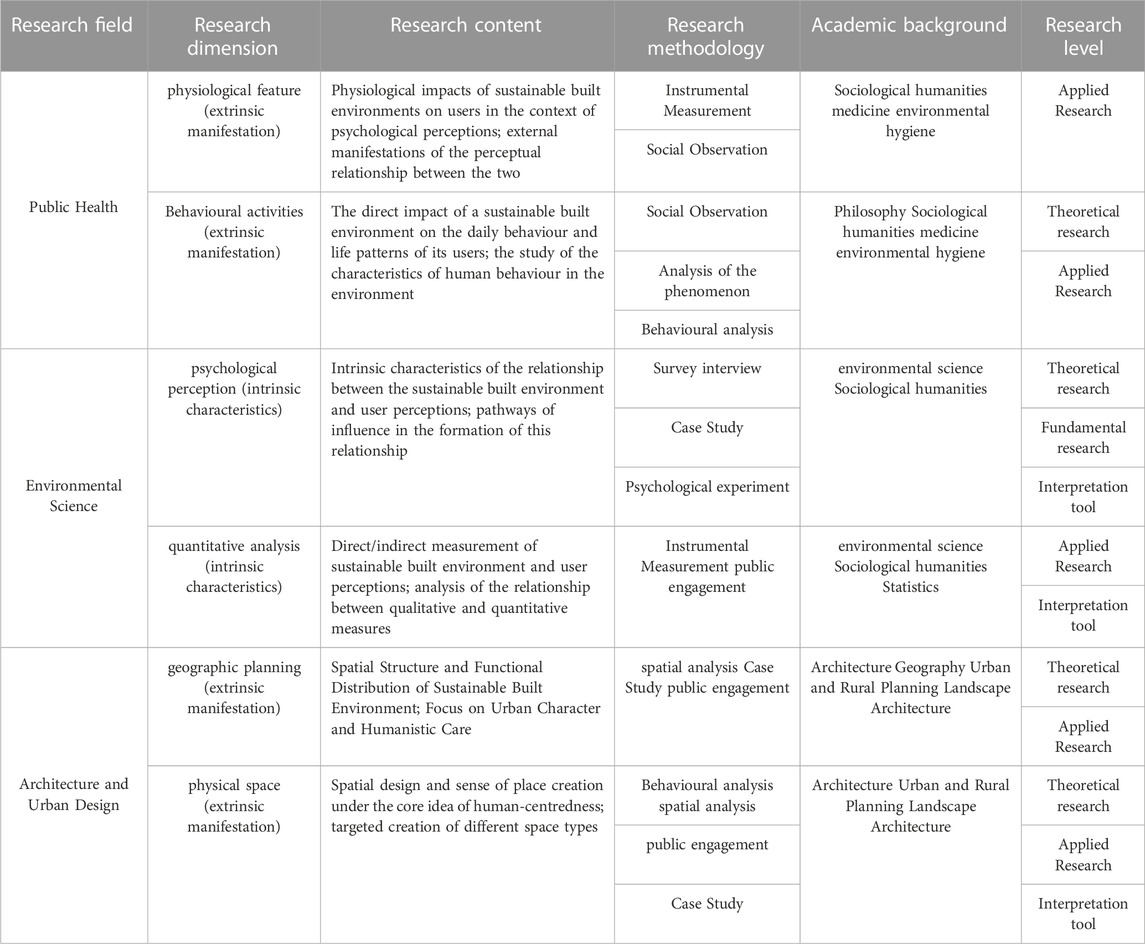
TABLE 4. Research results from various disciplines on the relationship between sustainable built environment and user perception.
5 Review and prospects of multidisciplinary relationships in the study of the relationship between sustainable built environment and user perception
Multidisciplinarity, in a narrow sense, refers to the interface between the natural sciences and the humanities, but also, more generally, to broader disciplines that involve the intersection of different disciplines. In general, research on the relationship between sustainable built environment and user perception has given rise to a network of disciplines, such as public, environmental, and occupational health, environmental science, building science and engineering, transport engineering, geography, and psychology, which lays down a disciplinary vein structure and provides a rich knowledge base and profound technical support for the field, in terms of both research structure and content. The interaction of the disciplines with the field and their complementarity create a distinctly multidisciplinary character.
5.1 Network relationships of research structures
The relationship between sustainable built environment and user perception is structured as one centre + two nodes + several branches (Figure 13A). The field of public health is the one centre, which initially studies the relationship between built environment and physical activity based on lifestyle from a public health perspective, followed by research hotspots such as travel behaviour and research models; the field of environmental science and the field of architecture and urban design are the two nodes, with perceptual contents such as safety, comfort, walkability, indoor thermal comfort, and urban research as research hotspots. The addition of subfields such as psychology, computer science, and sociology enriches the network density and hierarchy.
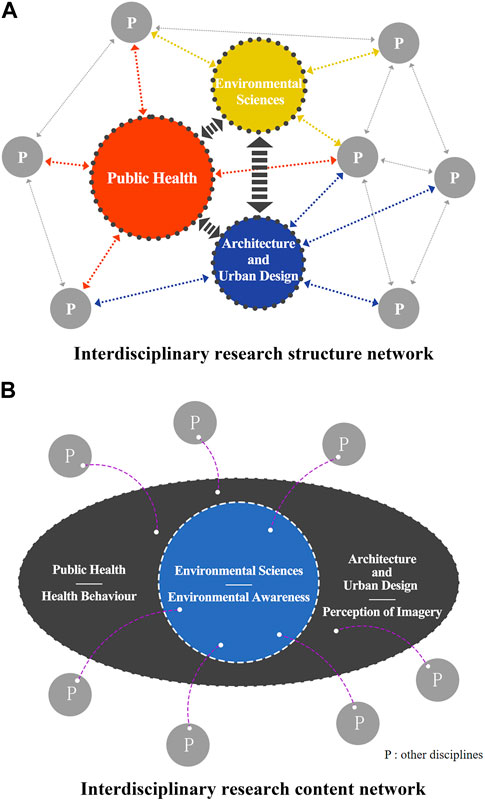
FIGURE 13. Interdisciplinary research network for the study of the relationship between sustainable built environment and user perception. (A) Interdisciplinary research structure network (B) Interdisciplinary research content network.
5.2 Network relationships of research content
The relationship between sustainable built environment and user perception is expressed in terms of research content in the form of concentric circles: core layer + outer circle (Figure 13B). Among the three main fields, the field of environmental science—environmental cognition—is the core, based on the study of users’ direct perception of built environment and its externalisation in the expression of activities such as ‘physical activity’, ‘urban design’. Of the various research fields in the outer circle, the fields of public health and architecture and urban design are not concerned with the study of perceptual content, but with the direct coupling of the relationship between the independent variable (built environment) and the dependent variable (externalised expression), using the results to speculate on the causal elements, while the other fields are more often added to the overall research network as research tools and grounded theory. The specific ways in which they affect each other are as follows.
5.2.1 Contribution of the public health to the study of perceptual relationships in the other two major fields
Public health is concerned with how the built environment affects the physical and mental health of its inhabitants. The findings from this field can provide environmental scientists with clues as to which environmental parameters—for example, air quality, water quality, or noise levels—may have a negative impact on health.
5.2.2 Contribution of the environmental science to the study of perceptual relationships in the other two major fields
Environmental science is responsible for measuring and monitoring key parameters of the built environment, which can provide a basis for public health research and improvement of indoor environments. The findings from this field can influence architecture and urban design. For example, research on indoor air quality can inspire architects to design better ventilation and filtration systems for the built environment that have a direct impact on the health and quality of life of its inhabitants.
5.2.3 Contribution of the architecture and urban design to the study of perceptual relationships in the other two major fields
Architecture shapes indoor environments by designing the layout, structure, and materials of buildings. Urban design improves urban environments by creating green spaces and walking/cycling paths and reducing traffic pollution, as well as by engaging the community and influencing behaviour. Public health can be influenced through community engagement, public space design, and urban planning that promotes healthy behaviours. Thoughtful design can inspire community residents to adopt healthier lifestyles.
5.3 Interdisciplinary collaboration and perspectives
Different research areas have different focuses and relative shortcomings. For example, the field of public health is more concerned with disease prevention, epidemiology, and the health and behaviour of users, and may lack a deeper understanding of the specific environmental parameters in architecture and urban design and how public health can be improved through design.
Interdisciplinary collaboration should capitalise on strengths in research content and pay more attention to the way in which the collaboration itself takes place: 1) Establish interdisciplinary research teams comprising public health experts, environmental scientists, and architects and urban designers to study the relationship between sustainable built environment and user perception. Such teams can work together to develop research plans, design experiments, collect data, and analyse results. 2) Share data and research tools across disciplines to better understand the links between sustainable built environment and user health and perception. 3) Jointly develop and apply integrated assessment methodologies that take into account the interactions between environmental parameters, social factors, and individual health, which may include the use of quantitative and qualitative methods to analyse, in an integrated manner, the impact of sustainable built environment on user perception. 4) Collaborate on field trials and case studies to test theories and drive innovation, for example, develop integrated construction projects in specific urban areas to test the impact of new urban planning and building design concepts on user health and perception.
6 Conclusion
Overall, the disciplines have different emphases in studying the relationship between sustainable built environment and user perception, and different network relationships in terms of research structure and content. In terms of research structure, the field of public health, which is researched earlier and published more papers, is taken as the centre, and the field of environmental science and the field of architecture and urban design are taken as the two nodes for subsequent development, forming a structure of ‘one centre + two nodes’. In terms of research content, environmental cognition in the field of environmental science is at the core, based on the study of users’ direct perception of the built environment and its reflection in behavioural performance, while the fields of public health and architecture and urban design are dominated by the study of perceptual outcomes. Currently, there is a trend towards close collaboration between the different disciplines working on this topic, and interdisciplinary work has an important role to play in the field of research on sustainable built environment and user perception, which requires the synthesis of knowledge and methods from different fields to study and solve problems in depth, and which can bring together people and ideas from different disciplines to construct problems, agree on methodologies, and analyse data, with the possibility of drawing new synthesised conclusions [E]. Methods from other fields can often solve the confusion of a single discipline, and the current means of measuring the object of study in various fields have a tendency to develop into big data. With the continuous deepening of the research and application of computer technology, such as the increasing improvement of web-based GIS technology, interdisciplinary and cross-sectoral research and technological synergies will become closer and closer, and the results of research on this topic will provide a steady stream of inspiration for the establishment of motivated lifestyle and behavioural habits in the future.
In the future, in order to improve the research network on sustainable built environment and user perception, it is necessary to further deepen the interdisciplinary cooperation and research content, build a more scientific and mature environmental spatial evaluation system, and then use quantitative analysis to study the inner mechanism of sustainable built environment on psychological perception, and further study the environmental psychological behaviour mechanism between the two, which will help enrich the civic activities, improve the street environment, create the community atmosphere, and form the spiritual image of the city. By visualising the information in the 1815 documents obtained from the search, the following conclusions can be drawn.
1. In terms of annual publication volume, research on the relationship between sustainable built environment and user perception has shown an increasing trend over the past 26 years, with the period from 2012 to the point of search showing a rapid increase in the number of articles on this topic, indicating that the dynamics of built environment–user relationship research will continue to be active in the future, and that there is a promising future for the analysis of built environment–user relationship from a perception perspective;
2. In terms of regional distribution, research in the US started early and developed to more maturity, followed by China, the United Kingdom, Australia, and Canada, but there are clear differences in the volume of research, with most of the Chinese studies occurring after 2015. In terms of author collaboration networks, the United Kingdom and US authors are well-established and their networks clear, with Ilse De Bourdeaudhuij, James F. Sallis, and Benedicte Deforche being the most influential in the field, and the trend of cross-discipline research leading to increasingly intensive collaborations between authors in the future;
3. At a disciplinary level, research on the relationship between the sustainable built environment and user perceptions has focused on ‘public, environmental & occupational health’, and since 2009, gradually moved towards ‘environmental studies’, ‘construction & building technology’, ‘engineering, civil’, and ‘geography’, with public health, environmental, and building engineering disciplines dominating the study, and a trend towards cross-disciplinarity that will lead to further integration in the future;
4. In terms of keyword co-occurrence, the keywords ‘health’, ‘walking’, ‘environment’, ‘impact, ‘behaviour’, ‘perception of behaviour’, and ‘design’ are core for this topic. The hotspots of research in this field are often related to people’s physical and mental health, which is highly compatible with the distribution of the subject areas. The keywords form a total of 12 sub-clusters—11 of which are under discussion—ranging from ‘thermal comfort’ and ‘physical activity’ to ‘quality’ and ‘neighbourhood environment’. The keyword emergence and timeline spectrum suggest a gradual convergence of research hotspots towards urban-scale, emerging technologies such as ‘neighbourhood design’, ‘city’, ‘virtual reality’, and ‘machine learning’, progressively using new tools and methods of research.
Author contributions
YY: Conceptualization, Data curation, Formal Analysis, Funding acquisition, Investigation, Methodology, Project administration, Resources, Supervision, Validation, Writing–review and editing. YH: Conceptualization, Data curation, Formal Analysis, Investigation, Methodology, Project administration, Resources, Software, Validation, Visualization, Writing–original draft. SL: Conceptualization, Data curation, Methodology, Software, Writing–review and editing.
Funding
The author(s) declare financial support was received for the research, authorship, and/or publication of this article. This research has been supported by National Natural Science Foundation of China (No.52008128).
Conflict of interest
The authors declare that the research was conducted in the absence of any commercial or financial relationships that could be construed as a potential conflict of interest.
Publisher’s note
All claims expressed in this article are solely those of the authors and do not necessarily represent those of their affiliated organizations, or those of the publisher, the editors and the reviewers. Any product that may be evaluated in this article, or claim that may be made by its manufacturer, is not guaranteed or endorsed by the publisher.
References
Alter, D. A., and Eny, K. (2005). The relationship between the supply of fast-food chains and cardiovascular outcomes. Can. J. Public Health 96, 173–177. doi:10.1007/BF03403684
Alvargonzález, D. (2011). Multidisciplinarity, interdisciplinarity, transdisciplinarity, and the sciences. Int. Stud. philosophy Sci. 25 (4), 387–403. doi:10.1080/02698595.2011.623366
Andrews, G. J., and Evans, J. (2008). Understanding the reproduction of health care: towards geographies in health care work. Prog. Hum. Geogr. 32 (6), 759–780. doi:10.1177/0309132508089826
Attwater, R., Booth, S., and Guthrie, A. (2005). The role of contestable concepts in transdisciplinary management of water in the landscape. Syst. Res. Behav. Sci. 22 (3), 185–192. The Official Journal of the International Federation for Systems Research. doi:10.1002/sres.668
Baran, P. K., Tabrizian, P., Zhai, Y., Smith, J. W., and Floyd, M. F. (2018). An exploratory study of perceived safety in a neighborhood park using immersive virtual environments. Urban For. Urban Green. 35, 72–81. doi:10.1016/j.ufug.2018.08.009
Barton, H. (2009). Land use planning and health and well-being. Land use policy 26, S115–S123. doi:10.1016/j.landusepol.2009.09.008
Bird, S., Kurowski, W., Feldman, S., Browning, C., Lau, R., Radermacher, H., et al. (2009). The influence of the built environment and other factors on the physical activity of older women from different ethnic communities. J. Women & Aging 21 (1), 33–47. doi:10.1080/08952840802633669
Bruce, D. G., Devine, A., and Prince, R. L. (2002). Recreational physical activity levels in healthy older women: the importance of fear of falling. J. Am. geriatrics Soc. 50 (1), 84–89. doi:10.1046/j.1532-5415.2002.50012.x
Brug, J., van Lenthe, F. J., and Kremers, S. P. (2006). Revisiting kurt lewin: how to gain insight into environmental correlates of obesogenic behaviors. Am. J. Prev. Med. 31 (6), 525–529. doi:10.1016/j.amepre.2006.08.016
Burton, E. (2012). Streets ahead? The role of the built environment in healthy ageing. Perspect. public health 132 (4), 161–162. doi:10.1177/1757913912449570
Cao, X. J., and Ettema, D. F. (2014). Satisfaction with travel and residential self-selection: how do preferences moderate the impact of the hiawatha light rail transit line? J. Transp. Land Use 7 (3), 93–108. doi:10.5198/jtlu.v7i3.485
Carr, L. J., Dunsiger, S. I., and Marcus, B. H. (2010). Walk score™ as a global estimate of neighborhood walkability. Am. J. Prev. Med. 39 (5), 460–463. doi:10.1016/j.amepre.2010.07.007
Cerin, E., Conway, T. L., Cain, K. L., Kerr, J., De Bourdeaudhuij, I., Owen, N., et al. (2013). Sharing good NEWS across the world: developing comparable scores across 12 countries for the neighborhood environment walkability scale (NEWS). BMC public health 13 (1), 309–314. doi:10.1186/1471-2458-13-309
Chen, C., Ibekwe-SanJuan, F., and Hou, J. (2010). The structure and dynamics of cocitation clusters: A multiple-perspective cocitation analysis. J. Am. Soc. Inf. Sci. Technol. 61 (7), 1386–1409. doi:10.1002/asi.21309
Chen, Y., Chen, C., Liu, Z., Hu, Z., Wang, X., Liu, Y., et al. (2015). Eight SNVs in NF-κB pathway genes and their different performances between subclinical mastitis and mixed Chinese Holstein cows. Stud. Sci. Sci. 33 (02), 242–249. doi:10.1016/j.gene.2014.11.011
Chen, Q., Fang, L., and Deng, Y. (2017). A study on neighborhood compound environment and walking behavior from thePerspective of heterogeneity:taking hangzhou as an example. City Plan. Rev. (9), 48–57. doi:10.11819/cpr20170907a
Chen, C., Tajnur, H., and Chen, Y. (2018). Built environment's influence on obesity of the older women and its planning responses. Hum. Geogr. 4, 76–81. doi:10.13959/j.issn.1003-2398.2018.04.011
Chen, C., Chen, J., Jia, Z., Deng, Z., Ma, S., Long, Y., et al. (2020). Large-scale measurement of the quality of urban street space based on physical disorder theory: A case study of area within the second ring of hefei city. South Archit. 25 (2), 10–18. doi:10.1186/s40001-020-00407-4
Chiou, S.-T., and Chen, L.-K. (2009). Towards age-friendly hospitals and health services. Archives gerontology geriatrics 49, S3–S6. doi:10.1016/S0167-4943(09)70004-4
Committee on Facilitating Interdisciplinary Research, National Academy of Sciences, National Academy of Engineering (1900). Facilitating interdisciplinary research. National Academies Press.
Cooper, C. L., and Marshall, J. (1976). Occupational sources of stress: A review of the literature relating to coronary heart disease and mental ill health. J. Occup. Psychol. 49 (1), 11–28. doi:10.1111/j.2044-8325.1976.tb00325.x
de Freitas, C. R., and Grigorieva, E. A. (2015). A comprehensive catalogue and classification of human thermal climate indices. Int. J. biometeorology 59, 109–120. doi:10.1007/s00484-014-0819-3
Diez Roux, A. V., and Mair, C. (2010). Neighborhoods and health. Ann. N. Y. Acad. Sci. 1186 (1), 125–145. doi:10.1111/j.1749-6632.2009.05333.x
Dong, H., and Qin, B. (2017). Exploring the link between neighborhood environment and mental wellbeing: A case study in Beijing, China. Landsc. Urban Plan. 164, 71–80. doi:10.1016/j.landurbplan.2017.04.005
Dong, W., Liu, Y., and Dong, Y. (2020). Measurement methods of urban residents' perception of built environment from a health perspective: A review. Sci. Technol. Rev. 38 (7), 61–68. doi:10.3981/j.issn.1000-7857
Edwards, D., and Burnard, P. (2003). A systematic review of stress and stress management interventions for mental health nurses. J. Adv. Nurs. 42 (2), 169–200. doi:10.1046/j.1365-2648.2003.02600.x
Evans, G. W., Wells, N. M., and Moch, A. (2003). Housing and mental health: A review of the evidence and a methodological and conceptual critique. J. Soc. issues 59 (3), 475–500. doi:10.1111/1540-4560.00074
Ewing, R., and Handy, S. (2009). Measuring the unmeasurable: urban design qualities related to walkability. J. Urban Des. 14 (1), 65–84. doi:10.1080/13574800802451155
Gee, G. C., and Payne-Sturges, D. C. (2004). Environmental health disparities: A framework integrating psychosocial and environmental concepts. Environ. health Perspect. 112 (17), 1645–1653. doi:10.1289/ehp.7074
Hong, J., and Chen, C. (2014). The role of the built environment on perceived safety from crime and walking: examining direct and indirect impacts. Transportation 41, 1171–1185. doi:10.1007/s11116-014-9535-4
Hur, M., Nasar, J. L., and Chun, B. (2010). Neighborhood satisfaction, physical and perceived naturalness and openness. J. Environ. Psychol. 30 (1), 52–59. doi:10.1016/j.jenvp.2009.05.005
Jf, S. (2006). Physical activity and the built environment, president's council on physical fitness and sports research digest. http://www.fitness.gov/publications/digests/december2006digest.pdf.18.
Jonasson, L. S., Nyberg, L., Kramer, A. F., Lundquist, A., Riklund, K., and Boraxbekk, C.-J. (2017). Aerobic exercise intervention, cognitive performance, and brain structure: results from the physical influences on brain in aging (PHIBRA) study. Front. Aging Neurosci. 8, 336. doi:10.3389/fnagi.2016.00336
Kearns, R., and Moon, G. (2002). From medical to health geography: novelty, place and theory after a decade of change. Prog. Hum. Geogr. 26 (5), 605–625. doi:10.1191/0309132502ph389oa
Kehrer, B. H., Andersen, R., and Glaser, W. A. (1972). A behavioral model of families' use of health services. J. Hum. Resour. 7 (1), 125. doi:10.2307/145064
Kerr, J., Emond, J. A., Badland, H., Reis, R., Sarmiento, O., Carlson, J., et al. (2016). Perceived neighborhood environmental attributes associated with walking and cycling for transport among adult residents of 17 cities in 12 countries: the IPEN study. Environ. health Perspect. 124 (3), 290–298. doi:10.1289/ehp.1409466
Kim, J. (2010). Neighborhood disadvantage and mental health: the role of neighborhood disorder and social relationships. Soc. Sci. Res. 39 (2), 260–271. doi:10.1016/j.ssresearch.2009.08.007
Kuo, F. E., Bacaicoa, M., and Sullivan, W. C. (1998). Transforming inner-city landscapes: trees, sense of safety, and preference. Environ. Behav. 30 (1), 28–59. doi:10.1177/0013916598301002
Lahti, J., Holstila, A., Lahelma, E., and Rahkonen, O. (2014). Leisure-time physical activity and all-cause mortality. PLoS One 9 (7), e101548. doi:10.1371/journal.pone.0101548
Lee, C., and Moudon, A. V. (2004). Physical activity and environment research in the health field: implications for urban and transportation planning practice and research. J. Plan. literature 19 (2), 147–181. doi:10.1177/0885412204267680
Li, F., Harmer, P., Cardinal, B. J., Bosworth, M., Johnson-Shelton, D., Moore, J. M., et al. (2009). Built environment and 1-year change in weight and waist circumference in middle-aged and older adults: portland neighborhood environment and health study. Am. J. Epidemiol. 169 (4), 401–408. doi:10.1093/aje/kwn398
Liberati, A., Altman, D. G., Tetzlaff, J., Mulrow, C., Gøtzsche, P. C., Ioannidis, J. P., et al. (2009). The PRISMA statement for reporting systematic reviews and meta-analyses of studies that evaluate health care interventions: explanation and elaboration. Ann. Intern. Med. 151, W-65–W94. doi:10.7326/0003-4819-151-4-200908180-00136
Liu, B., and Guo, C. (2006). Promoting health through design: A brief ntroduction of“Active living byDesign”,An American national program. Urban Plan. Int. 21 (2), 60–65. CNKI:SUN:GWCG.0.2006-02-012.
Liu-Ambrose, T., Khan, K. M., Eng, J. J., Janssen, P. A., Lord, S. R., and Mckay, H. A. (2004). Resistance and agility training reduce fall risk in women aged 75 to 85 with low bone mass: A 6-month randomized, controlled trial. J. Am. Geriatrics Soc. 52 (5), 657–665. doi:10.1111/j.1532-5415.2004.52200.x
Long, Y., and Tang, J. (2019). Large-scale quantitative measurement of the quality of urban street space: the research progress. City Plan. Rev. 43, 107–114. doi:10.11819/cpr20190616a
Long, Y. (2016). Street urbanism: A new perspective for urban studies and city planning in the new data environment. Time+ Archit. 2, 128–132. doi:10.13717/j.cnki.ta.2016.02.019
Lu, F., Tan, S., Wang, Y. H., Ma, H. D., Tang, W., Yang, J. B., et al. (2015). Built environment's influence on physical activity: review and thought. Urban Plan. Int. 30 (2), 62–72. CNKI:SUN:GWCG.0.2015-02-011. doi:10.1016/j.jaut.2015.05.008
Ma, M., Cai, Z., Michaelides, A., and Aeppli, G. (2016). Fast diffusion of water nanodroplets on graphene. Chin. Landsc. Archit. 32 (11), 66–71. CNKI:SUN:ZGYL.0.2016-11-014. doi:10.1038/nmat4449
Ma, M., zhou, J., Cai, z., Liu, J., Liang, Y., Zhang, C. D., et al. (2019). ZEB1-AS1 initiates a miRNA-mediated ceRNA network to facilitate gastric cancer progression. J. Hum. Settlements West China 34 (4), 27–34. doi:10.1186/s12935-019-0742-0
Maas, J., Van Dillen, S. M., Verheij, R. A., and Groenewegen, P. P. (2009). Social contacts as a possible mechanism behind the relation between green space and health. Health & place 15 (2), 586–595. doi:10.1016/j.healthplace.2008.09.006
Macmillan, A., Hosking, J., Connor, J., Bullen, C., and Ameratunga, S. (2013). A cochrane systematic review of the effectiveness of organisational travel plans: improving the evidence base for transport decisions. Transp. policy 29, 249–256. doi:10.1016/j.tranpol.2012.06.019
Monda, K. L., Gordon-Larsen, P., Stevens, J., and Popkin, B. M. (2007). China's transition: the effect of rapid urbanization on adult occupational physical activity. Soc. Sci. Med. 64 (4), 858–870. doi:10.1016/j.socscimed.2006.10.019
Morland, K., Roux, A. V. D., and Wing, S. (2006). Supermarkets, other food stores, and obesity: the atherosclerosis risk in communities study. Am. J. Prev. Med. 30 (4), 333–339. doi:10.1016/j.amepre.2005.11.003
Nagel, C. L., Carlson, N. E., Bosworth, M., and Michael, Y. L. (2008). The relation between neighborhood built environment and walking activity among older adults. Am. J. Epidemiol. 168 (4), 461–468. doi:10.1093/aje/kwn158
Nielsen, T. S., and Hansen, K. B. (2007). Do green areas affect health? Results from a Danish survey on the use of green areas and health indicators. Health & place 13 (4), 839–850. doi:10.1016/j.healthplace.2007.02.001
Petts, J., Owens, S., and Bulkeley, H. (2008). Crossing boundaries: interdisciplinarity in the context of urban environments. Geoforum 39 (2), 593–601. doi:10.1016/j.geoforum.2006.02.008
Qin, B., Zhu, W., and Dong, H. (2018). The influence of neighborhood environment and transportation on residents’ mental wellbeing: based on questionnaire of 16 communities in beijing. Urban Rural. Plan. 3, 38–46. doi:10.12049/j.urp.201803005
Rantanen, T., Portegijs, E., Viljanen, A., Eronen, J., Saajanaho, M., Tsai, L.-T., et al. (2012). Individual and environmental factors underlying life space of older people–study protocol and design of a cohort study on life-space mobility in old age (LISPE). BMC Public Health 12, 1–17. doi:10.1186/1471-2458-12-1018
Reyers, B., Roux, D. J., Cowling, R. M., Ginsburg, A. E., Nel, J. L., and Farrell, P. O. (2010). Conservation planning as a transdisciplinary process. Conserv. Biol. 24 (4), 957–965. doi:10.1111/j.1523-1739.2010.01497.x
Rockhill, B., Willett, W. C., Manson, J. E., Leitzmann, M. F., Stampfer, M. J., Hunter, D. J., et al. (2001). Physical activity and mortality: A prospective study among women. Am. J. Public Health 91 (4), 578–583. doi:10.2105/ajph.91.4.578
Rodríguez, D. A., Evenson, K. R., Roux, A. V. D., and Brines, S. J. (2009). Land use, residential density, and walking: the multi-ethnic study of atherosclerosis. Am. J. Prev. Med. 37 (5), 397–404. doi:10.1016/j.amepre.2009.07.008
Sallis, J. F., Cervero, R. B., Ascher, W., Henderson, K. A., Kraft, M. K., and Kerr, J. (2006). An ecological approach to creating active living communities. Annu. Rev. Public Health 27, 297–322. doi:10.1146/annurev.publhealth.27.021405.102100
Sallis, J. F., Carlson, J. A., Mignano, A. M., Lemes, A., and Wagner, N. (2013). Trends in presentations of environmental and policy studies related to physical activity, nutrition, and obesity at society of behavioral medicine, 1995–2010: A commentary to accompany the active living research supplement to annals of behavioral medicine. Ann. Behav. Med. 45 (1), S14–S17. doi:10.1007/s12160-012-9415-0
Skalicky, V., and Čerpes, I. (2019). Comprehensive assessment methodology for liveable residential environment. Cities 94, 44–54. doi:10.1016/j.cities.2019.05.020
Tang, J., and Long, Y. (2017). Metropolitan street space quality evaluation: second and third ring of Beijing, inner ring of shanghai. Planners 33 (2), 68–73. doi:10.3969/j.issn.1006-0022.2017.02.011
Tinetti, M. E., and Kumar, C. (2010). The patient who falls:“It's always a trade-off”. Jama 303 (3), 258–266. doi:10.1001/jama.2009.2024
Trapp, G. S., Giles-Corti, B., Christian, H. E., Bulsara, M., Timperio, A. F., McCormack, G. R., et al. (2012). Increasing children’s physical activity: individual, social, and environmental factors associated with walking to and from school. Health Educ. Behav. 39 (2), 172–182. doi:10.1177/1090198111423272
Tress, B., Tress, G., and Fry, G. (2005). Researchers’ experiences, positive and negative, in integrative landscape projects. Environ. Manag. 36, 792–807. doi:10.1007/s00267-005-0038-0
Van Cauwenberg, J., Van Holle, V., Simons, D., Deridder, R., Clarys, P., Goubert, L., et al. (2012). Environmental factors influencing older adults’ walking for transportation: A study using walk-along interviews. Int. J. Behav. Nutr. Phys. activity 9, 85–11. doi:10.1186/1479-5868-9-85
Van den Berg, A. E., Maas, J., Verheij, R. A., and Groenewegen, P. P. (2010). Green space as a buffer between stressful life events and health. Soc. Sci. Med. 70 (8), 1203–1210. doi:10.1016/j.socscimed.2010.01.002
Wallace, B., Barnes, J., and Rutherford, G. S. (2000). Evaluating the effects of traveler and trip characteristics on trip chaining, with implications for transportation demand management strategies. Transp. Res. Rec. 1718 (1), 97–106. doi:10.3141/1718-13
Wang, L., Sun, W., and Wu, Y. (2020a). Study on the impact of subjective perception of urban environment on residents' health: based on a large sample survey of 60 counties and cities in China. Hum. Geogr. 35 (2), 55–64. doi:10.13959/j.issn.1003-2398.2020.02.007
Wang, R., Niu, Q., Gao, H., Huang, S., and Xu, Z. (2020b). Quantitative research and evaluation on street lnterface of historic district A case of sanhe ancient town in hefei. Urbanism Archit. 17 (28), 15–19+56. doi:10.19892/j.cnki.csjz.2020.28.03
Wang, M., Mauleon, R., Hu, Z., Chebotarov, D., Tai, S., Wu, Z., et al. (2018). Research on community ldentity,Emotional structure of the Environment,and urban morphogenetic mechanism:based on the measurement and evaluation of caoyang xincun in shanghai. City Plan. Rev. 42 (12), 43–49. doi:10.1038/s41586-018-0063-9
Won, S., Lee, Y., and Park, Y. (2020). The impact of signboard-building color combinations on color harmony and legibility. Color Res. Appl. 45 (3), 527–541. doi:10.1002/col.22480
Wu, J. (2021). Three forms of multidisciplinary research. Bull. Natl. Nat. Sci. Found. China 35 (2), 5. doi:10.16262/j.cnki.1000-8217.2021.02.002
Xi, T., Kuang, X., Zhu, Y., and Fu, X. (2019). An exploration of the street renewal design based on human perception:A case study of the beautiful district renovation program in pengpu Town,Jing'an District,Shanghai. Urban Plan. Forum. doi:10.16361/j.upf.201907020
Xian Yu, J. C., Juan, Z. C., Gao, L. J., Ni, A. N., Zhang, W., and Wu, B. (2011). Empirical analysis of commuters’ nonwork stop-making behavior in Beijing, China. J. Transp. Eng. 137 (5), 360–369. doi:10.1061/(ASCE)TE.1943-5436.0000228
Yang, J., and French, S. (2013). The travel—obesity connection: discerning the impacts of commuting trips with the perspective of individual energy expenditure and time use. Environ. Plan. B Plan. Des. 40 (4), 617–629. doi:10.1068/b38076
Zhang, F., Zhou, B., Liu, L., Liu, Y., Fung, H. H., Lin, H., et al. (2018). Measuring human perceptions of a large-scale urban region using machine learning. Landsc. Urban Plan. 180, 148–160. doi:10.1016/j.landurbplan.2018.08.020
Zhong, T., Ye, C., Wang, Z., Tang, G., Zhang, W., and Ye, Y. (2021). City-scale mapping of urban façade color using street-view imagery. Remote Sens. 13 (8), 1591. doi:10.3390/rs13081591
Keywords: multidisciplinary vision, sustainable built environment, user perception, Citespace, health behaviour, urban landscape
Citation: Ye Y, Huang Y and Li S (2023) A multidisciplinary perspective on the relationship between sustainable built environment and user perception: a bibliometric analysis. Front. Built Environ. 9:1271889. doi: 10.3389/fbuil.2023.1271889
Received: 03 August 2023; Accepted: 26 September 2023;
Published: 10 October 2023.
Edited by:
Vagelis Plevris, Qatar University, QatarReviewed by:
Nimish Biloria, University of Technology Sydney, AustraliaShenjun Yao, East China Normal University, China
Copyright © 2023 Ye, Huang and Li. This is an open-access article distributed under the terms of the Creative Commons Attribution License (CC BY). The use, distribution or reproduction in other forums is permitted, provided the original author(s) and the copyright owner(s) are credited and that the original publication in this journal is cited, in accordance with accepted academic practice. No use, distribution or reproduction is permitted which does not comply with these terms.
*Correspondence: Yang Ye, eWV5YW5nQGhpdC5lZHUuY24=
 Yang Ye*
Yang Ye* Yi Huang
Yi Huang
